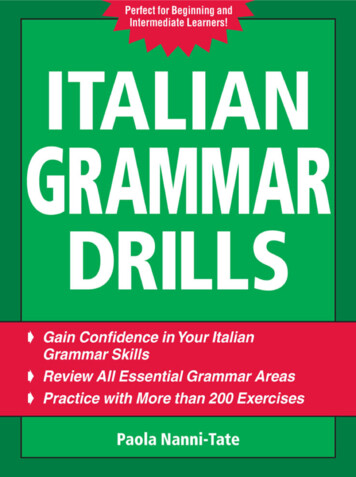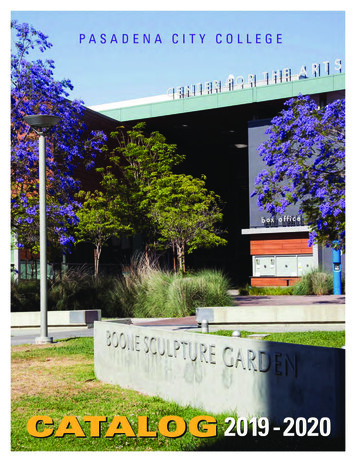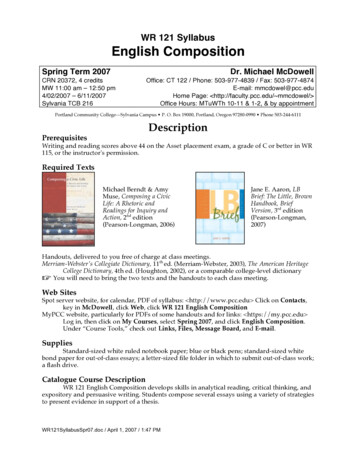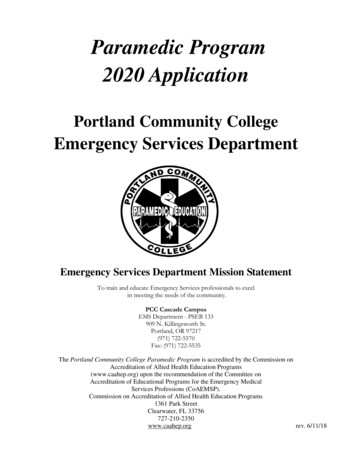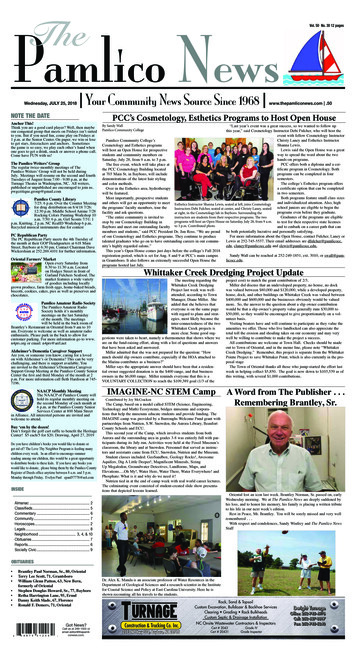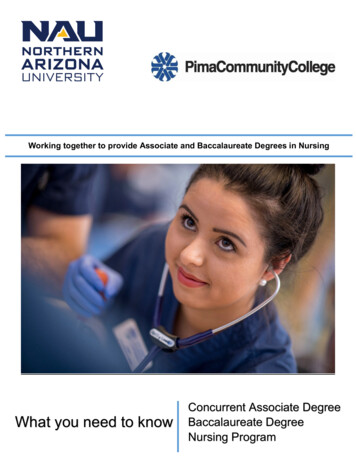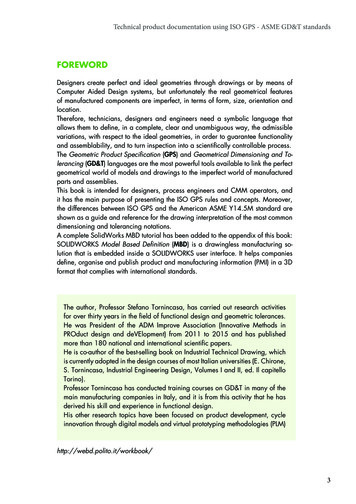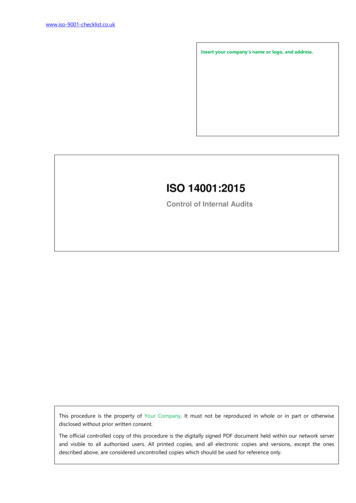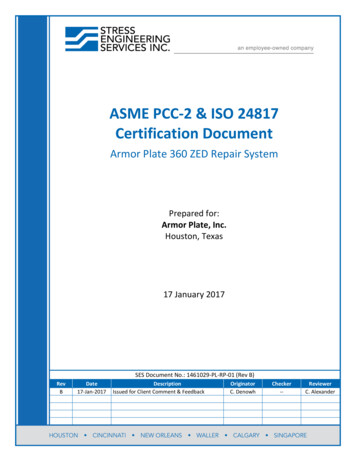
Transcription
ASME PCC-2 & ISO 24817Certification DocumentArmor Plate 360 ZED Repair SystemPrepared for:Armor Plate, Inc.Houston, Texas17 January 2017SES Document No.: 1461029-PL-RP-01 (Rev B)RevBDate17-Jan-2017DescriptionIssued for Client Comment & FeedbackOriginatorC. DenowhChecker--ReviewerC. Alexander
ASME PCC-2 & ISO 24817Certification DocumentArmor Plate 360 ZED Repair SystemSES Document No.: 1461029-PL-RP-01 (Rev B)17 January 2017Prepared for:Armor Plate, Inc.Houston, TexasPrepared by:Chantz Denowh, PhDAnalystReviewed by:Dr. Chris Alexander, PEPrincipalStress Engineering Services, Inc.13800 Westfair East DriveHouston, Texas 77041-1101Phone: 281-955-2900Web: www.stress.comTexas Registered Engineering Firm F-195
Armor Plate, Inc.ASME PCC-2 & ISO 24817 Certification Document – Armor Plate 360 ZED Repair System17 January 2017Limitations of This ReportThis report is prepared for the sole benefit of the Client, and the scope is limited to matters expresslycovered within the text. In preparing this report, SES has relied on information provided by the Clientand, if requested by the Client, third parties. SES may not have made an independent investigation as tothe accuracy or completeness of such information unless specifically requested by the Client orotherwise required. Any inaccuracy, omission, or change in the information or circumstances on whichthis report is based may affect the recommendations, findings, and conclusions expressed in this report.SES has prepared this report in accordance with the standard of care appropriate for competentprofessionals in the relevant discipline and the generally applicable industry standards. However, SES isnot able to direct or control operation or maintenance of the Client’s equipment or processes.Stress Engineering Services, Inc.Page iiiSES Doc. No.: 1461029-PL-RP-01 (Rev B)
Armor Plate, Inc.ASME PCC-2 & ISO 24817 Certification Document – Armor Plate 360 ZED Repair System17 January 2017Executive SummaryStress Engineering Services, Inc. (SES) was contracted by Armor Plate, Inc. (AP) to perform anindependent technical assessment of their AP 360 ZED (ZED) pipeline repair system with respect to thequalification requirements of ASME PCC-2-2015 (2015 edition), Repair of Pressure Equipment and Pipe,Article 4.1, Nonmetallic Composite Repair Systems for Pipelines and Pipework: High-Risk Applications.The ZED resin system has been formulated for cold weather environments where lower temperatureconditions pose challenges for curing on conventional epoxy resin systems.The ASME PCC-2 standard provides composite manufacturers and operators with a comprehensiveuniform approach for the proper design of composite repair systems based on required coupon materialproperties testing, along with assessing overall system performance using full-scale testing. Includedwithin this review is a comprehensive assessment to validate that the ZED pipeline repair system isadequately designed for its intended use in accordance with ASME PCC-2 at elevated temperatures at orbelow 104 F. The emphasis of the work performed by SES in this assessment is the repair andreinforcement of high pressure transmission pipelines.Testing performed by Stress Engineering Services Inc. (SES) has demonstrated that the AP 360 ZED repairsystem meets the minimum requirements of ASME PCC-2-2015 (2015 edition), Article 4.1- NonmetallicComposite Repair Systems: High Risk Applications for application temperatures at or below 104 F.The table below summarizes the results from the ASME PCC-2 qualification tests including coupontesting, spool survival, and 1000-hr long-term strength. In addition to testing required by ASME PCC-2,SES requires two additional tests before certifying a repair system. Both involve the repair of pipesamples made using 12.75-inch x 0.375-inch, Grade X42 pipe with 75% deep corrosion. The firstmeasures the inter-layer strains during a static pressure test to failure. The inter-layer strains (andcorresponding stresses) are compared to design stresses per ASME PCC-2. The second test is a pressurecycle fatigue test to provide useful information on the long-term performance of the repair. All theabove testing was completed at or above temperatures of 104 F. The results confirm that the AP 360ZED composite repair system meets the minimum requirements designated in the ASME PCC-2-2015Standard for applications at or below temperatures of 104 F.1The applicability of the results associated with the testing work completed by SES in this study are basedon the premise that all materials, techniques, and installation methods used to repair actual pipelineanomalies are consistent with those used in completing the tests detailed in this report, including thoseassociated with testing specific to ASME PCC-2. Any certified designs using the AP 360 ZED repair systemmust meet the minimum composite thickness requirements of ASME PCC-2-2015 (based off theminimum thickness formulas).1The temperature range over which the ZED resin system has been tested up to 104 F. Coupon testing has been conducteddown to -40 F with no apparent loss of strength, elastic modulus, or elongation.Stress Engineering Services, Inc.Page ivSES Doc. No.: 1461029-PL-RP-01 (Rev B)
Armor Plate, Inc.ASME PCC-2 & ISO 24817 Certification Document – Armor Plate 360 ZED Repair System17 January 2017Armor Plate ZED – ASME PCC-2 Qualification Test SummaryPropertyDetailsTemperatureTest StandardTest ore DHoop--Above 32 F-ASTM D 3039ASTM D 3039ASTM D 3039ASTM D 3039ASTM D 3039ASTM D 3039ASTM D 3039ASTM D 3039ASTM D 3039ASTM D 3039ASTM D 3039ASTM D 3039ASTM D695ASTM D695ASTM D695ASTM D695ASTM D 3039ASTM D 2583ASTM E 8310.062573,200 psi2.1%3,565,000 psi60,700 psi1.7%3,579,000 psi9,8501.9%1,328,0009,5001.9%1,196,000536,400 psi11,200 psi208,500 psi7,600 psi0.22290.234.8·10-6 1/ FCTE*AxialAbove 32 FASTM E 83116.0·10-6 1/ FGlass Transition Temp - TgFillerASTM E 1640128 FGlass Transition Temp - TgEpoxyASTM E 1640121 FLayer ThicknessTensile StrengthUltimate Tensile StrainModulusTensile StrengthUltimate Tensile StrainModulusTensile StrengthUltimate Tensile StrainModulusTensile StrengthUltimate Tensile StrainModulusCompressive ModulusCompressive StrengthCompressive ModulusCompressive StrengthPoisson's RatioHardnessCTE*Lap Shear AdhesionCathodic Disbondment104 F70 F104 F70 F104 FN/AAdhesivestrength70 F104 FASTM D 5868ASTM D 58685,1007,40028 Day TestDurationN/ANACE TM01152015No ObservedDisbondmentASME PCC-2ASME PCC-2SES AdditionalSES Additional23,760 psiSurvivedCompletedCompletedLong Term Strength1,000 hoursSpool Survival Test75% WT DefectInter-Layer Strain75% WT DefectPressure Cycle Fatigue75% WT Defect*CTE - Coefficient of Thermal ExpansionStress Engineering Services, Inc.70 F104 F104 FPage vSES Doc. No.: 1461029-PL-RP-01 (Rev B)
Armor Plate, Inc.ASME PCC-2 & ISO 24817 Certification Document – Armor Plate 360 ZED Repair System17 January 2017Table of ContentsLimitations of This Report . iiiExecutive Summary. iv1. Introduction . 12. Test Sample Preparation . 22.1 Pipe Test Samples . 23. ASME PPC-2 Qualification Tests . 53.1 Mandatory Appendix II – Qualification Data for the ZED Repair System . 53.2 Mandatory Appendix III – Short-Term Pipe Spool Survival Test. 73.3 Mandatory Appendix V – Measurement of Performance Test Data . 103.3.1 Testing Program Details. 113.3.2 Pre-Hold Burst Test. 123.3.3 1,000 Hour Test Results . 133.4 ASME PCC-2 and ISO 24817 Comparison . 154. Strain Based Performance Verification. 174.1 Inter-Layer Strain Measurement . 174.2 Inter-Layer Strain Results . 184.3 Pressure Cycle Fatigue Test . 235. ASME PCC-2 Verification . 266. Closing Comments . 30Appendix A: Comparison of ASME PCC-2 and ISO 2481Appendix B: Pipe Sample Mechanical TestingStress Engineering Services, Inc.Page viSES Doc. No.: 1461029-PL-RP-01 (Rev B)
Armor Plate, Inc.ASME PCC-2 & ISO 24817 Certification Document – Armor Plate 360 ZED Repair System17 January 2017List of TablesTable 3-1: Summary of composite repair material properties . 6Table 4-1: Measure hoop and axial strains at layers 1, 3, 5, and 7 at 72% and 100% SMYS (all valuesin microstrain – 10,000 microstrain 1.0% strain) . 21Table 4-2: Hoop and axial inter-layer stress values at 72% SMYS (1,780 psi) calculated frommeasured strain values . 22Table 4-3: Hoop and axial inter-layer stress values at 100% SMYS (2,740 psi) calculated frommeasured strain values . 22Table 4-4: Sample strains after 200 pressure cycles . 24Table 4-5: Sample strains after 100,000 pressure cycles . 25Table 5-1: AP ZED Repair System ASME PCC-2 Qualification Test Summary. 27Table 5-2: Design stresses as a function of the ASME PCC-2 Service Factor . 28Table 5-3: Annual pressure cycle data for typical gas pipelines (Kiefner et al) . 29Stress Engineering Services, Inc.Page viiSES Doc. No.: 1461029-PL-RP-01 (Rev B)
Armor Plate, Inc.ASME PCC-2 & ISO 24817 Certification Document – Armor Plate 360 ZED Repair System17 January 2017List of FiguresFigure 2-1: Schematic diagram showing details on the corroded pipe samples . 3Figure 2-2: Details on strain gage locations for corroded pipe samples. 4Figure 3-3: Spool survival thickness calculations . 8Figure 3-4: ZED spool survival sample in burst tube pre-test . 9Figure 3-5: Internal pressure vs. hoop strain for ZED spool survival test . 9Figure 3-6: ZED spool survival sample after failure – maximum pressure 4,167 psi . 10Figure 3-7: Three ZED 1,000 hour samples in insulated box. 12Figure 3-8: Internal pressure vs. hoop strain for 1,000hr pre-burst test . 13Figure 3-9: ZED 1,000 hour pressure and temperature data vs. elapsed time . 14Figure 3-10: Calculation of long-term design stress for ZED repair system according Appendix V,Equation V-2 . 15Figure 4-1: Inter-layer strain sample after burst test . 18Figure 4-2: Pressure and temperature vs. time for the ZED inter-layer burst test . 19Figure 4-3: Internal pressure vs. hoop strain (in microstrain) for the ZED inter-layer strain gages . 19Figure 4-4: Summary of strain measurements from the PRCI MATR-3-4 program – measurementsfrom 12 samples repaired using different composite materials 12.75-inch x 0.375-inch,Grade X42 with 75% corrosion . 20Figure 4-5: Hoop strains at the corroded region R1, on the filler, and at layers 2, 4, 6, 8, and on topof the composite at 72% SMYS (1,780 psi) and 100% SMYS (2,470 psi) pressure levels. 21Figure 4-6: Biaxial stress calculations for a composite material for inter-layer gage 2 at 72% SMYSpressure .
Table 5-1: AP ZED Repair System ASME PCC-2 Qualification Test Summary. 27 Table 5-2: Design stresses as a function of the ASME PCC-2 Service Factor . 28 Table 5-3: Annual pressure cycle data for typical gas pipelines (Kiefner et al) . 29 . Armor Plate, Inc. ASME PCC-2 & ISO 24817 Certification Document – Armor Plate 360 ZED Repair System 17 January 2017 Stress Engineering .


